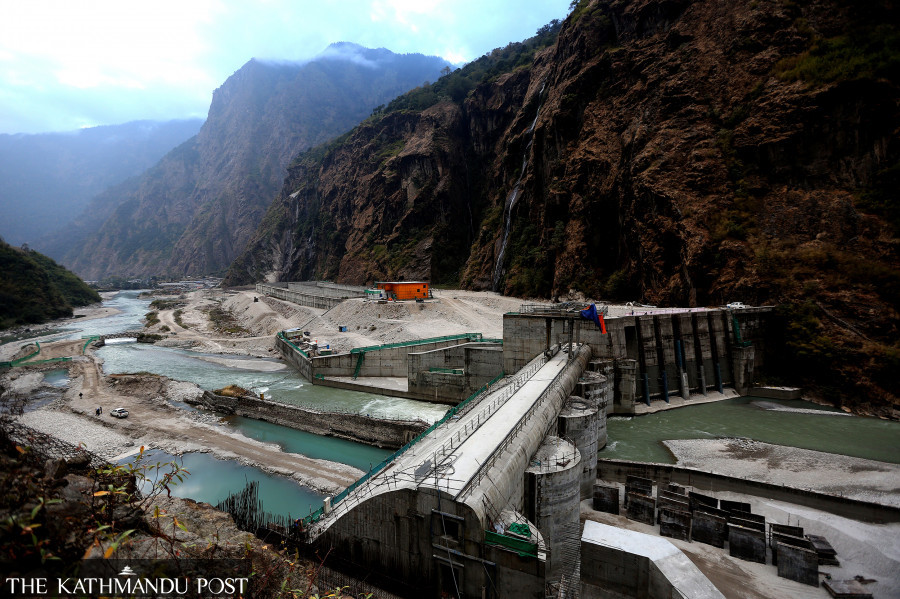Climate & Environment
Increasingly deadlier landslides imperil Nepal’s hydel hopes
The country’s problem, say experts, is its extreme geological diversity and the progressively complicated rainfall patterns.
Arpan Shrestha
At around 4 pm on June 15 last year, hydropower engineer Bimal Gurung received an alert from his on-site monitoring team about debris flow and flooding in the upstream areas of Upper Tamakoshi Hydropower Project.
“The sudden event sighted through surveillance cameras wasn’t anything alarming then,” said Gurung, technical chief at Nepal’s largest hydropower project based in Dolakha, the northeastern district that borders China.
But things quickly turned worrisome when China warned three days later that a tributary of Tamakoshi river was dammed on its side due to several landslides upstream of the 456 MW hydropower project’s catchment area, creating flood risk for downstream Nepal.
“Between June 15 and 18, there was no communication between Nepal and China,” Gurung said, lamenting the lack of cross-border messaging to better prepare and mitigate the risks. “Our catchment area has upstream vulnerabilities, but we have no access to the Chinese side for field investigation.”
The ‘late warning’ left Nepali authorities scrambling for a response. The Dolakha district administration issued a notice at 9:45 pm, warning of a flash flood and requesting communities along the Tamakoshi river to move to safer places.
Security personnel were mobilised late at night in settlements along the Tamakoshi river to relocate the at-risk residents. Further downstream, the district administrations of Ramechhap and Sindhuli also issued similar warnings.
Meanwhile, Gurung and his team closely studied the situation to mitigate the damage, confident that the project’s design can withstand worst-case scenario floods, even if the Tsho Rolpa glacial lake bursts. “The dam can handle 5,000 cubic metres of water per second,” he said.
The following day, the reservoir lowered its water level to avert any untoward incident, as the risks downstream were immediate.
“It was good that they made room for floodwater,” said Madhukar Upadhya, a watershed expert well-versed on climate-related disasters. “It could have gone wrong as it did in Pakistan this year.”
It was a big relief for Nepal when China eventually cleared the landslide dam and the water level got back to normal. A major incident had been averted that week which saw pre-monsoon rains wreaking havoc across the country, with the most devastating damages seen in Sindhupalchok district.
Following incessant rain from June 13–15, a combination of flash floods and landslide dams resulted in fast-moving mudslides, which swept away settlements in Helambu and Melamchi Bazaar and even damaged the headworks of the Melamchi Water Supply Project, which had just begun its preliminary test operations.
“One disaster leads to another, compounding the threats and increasing our challenges to mitigate them,” said Upadhya, the author of ‘Pokhari ra Pahiro’ (Ponds and Landslides), the landmark book on Nepal’s mid-hills and mountains.
“The widespread alteration of the land surface in the name of development has changed the way monsoon rain flows down in a concentrated way and aggravated the natural process of landslides, making them deadlier,” Upadhya added. “The process is further worsened by an increase in extreme and short duration rain to add to the deadly runoff.”
Nepal’s problem, Upadhya says, is its extreme geological diversity and increasingly complicated rainfall behaviour that limits infrastructure projects. He says that understanding this complexity to improve interventions through programmes and not projects is the biggest challenge to mitigating the risks.
“The mid-hills and high mountains have their unique characteristics, and experience derived from one place could be useless in another, but we lump every landslide problem in one basket.”
While a major disaster was averted in the Tamakoshi river, the devastation in Helambu and Melamchi shows how abrupt climate events could trigger a domino effect with increasing evidence through the frequency of landslide dam incidents in the high mountain and hill areas where the country’s hydropower projects are located.
“The northern border area, which lies in the central thrust of the Himalayas, is a weak zone, susceptible to frequent landslides,” Upadhya said. “The other serious problems are gullies and small-scale landslides in and around the settlements that result in massive debris flow during the monsoon. All these put limits on any big infrastructure, including hydropower.”
According to scientists, the northern border area is also one of the most affected by the climate crisis and seismic hazards, resulting in increasingly frequent and deadlier landslides.
The landslides triggered by the 2015 twin earthquakes caused severe damage to more than 30 hydropower projects, temporarily knocking off 20 percent of the national electricity grid. A 2018 study published in the journal Geophysical Research Letters also warns that there is a limit to hydropower expansion in the Himalayas and earthquake-triggered landslides threaten Nepal’s hydropower projects.
The study predicts that a quarter of the 274 hydropower projects in operation, under construction or being planned in India, Nepal and Bhutan are likely to face severe damage from quake-triggered landslides. In Nepal, the Independent Power Producers are building projects totaling 2,781 MW while the Nepal Electricity Authority is undertaking projects with a total capacity of 943 MW, according to a recent World Bank report.
Dave Petley, an earth scientist and vice-chancellor at the University of Hull in the United Kingdom, said he is worried about the wave of hydroelectric projects being constructed in the steep river systems of Nepal (and elsewhere).
“I am also worried that sites being impacted by large landslides and debris flows haven't been properly considered,” he said. “There is also the threat of a major earthquake, which would impact the facilities directly, but, more worryingly, would trigger landslides upstream that would threaten the facilities over the long term.”
But seismic hazards aside, the rise in landslide events would be significant in the border regions of Nepal and China, according to a 2020 NASA report, which projects a surge anywhere between 30 percent to 70 percent.
Landslides would occur in areas covered by glaciers and glacial lakes, according to the study.
Glacial lake outburst floods are imminent threats not just in Nepal but also upstream in China, like the most recent one in 2016 when the small Gongbatongsha glacier lake outburst flood, triggered by heavy precipitation, resulted in a massive transborder flooding and debris flow which swept parts of the Arniko Highway and severely damaged the Upper Bhotekoshi Hydropower Project.
“We have been investigating the glacier situation every five to 10 years using satellite imagery and regular field visits, but we need more scientific studies on the threats they pose to our hydropower projects,” said Gurung, who has spent more than 25 years in Nepal’s hydropower sector with experience at the Kali Gandaki Hydroelectric Power Station and Chilime Hydropower Plant.
“A cross-border exchange of knowledge to avert or mitigate disasters is also needed urgently. The Foreign Ministry and the Department of Hydrology and Meteorology should establish communication channels with neighbouring countries. ”
The alarm bells over a possible flood in the Tamakoshi river last year were a stitch in time, although there was no certainty as to what could have gone wrong that day, experts say.
In 2014, a massive Jure landslide in Sindhupalchok dammed the Sunkoshi River to form a 55-metre-high lake with potential cross-border consequences in India. A catastrophe was averted and vulnerable populations downstream and across the border were evacuated to safer zones, thanks to a warning system in place.
The Jure disaster, one of the deadliest landslides in Nepal’s history, killed 156 people and destroyed everything in its path, including the country’s only road connection to China. The dammed lake it formed submerged a hydropower station upstream and damaged another hydropower station downstream.
It was a moment of relief when the lake was drained out, preventing a massive cross-border disaster downstream. But landslides and the dangerous dams they could form, especially at higher elevations, have started to pose more problems across the Himalayas as evident in the recent extreme events in Nepal and South Asia, calling for cross-border actions and a warning system in place.
Nepal’s experience with extreme climate events and cascading disasters reveals a dearth of knowledge to prepare and mitigate climate risks.
Take, for instance, the 1993 record-breaking one-day high-intensity rainfall of 540 mm in the central region that seriously damaged two hydropower stations and the Kulekhani reservoir and triggered devastating debris flow, flash floods and hundreds of landslides.
“Our knowledge about cloudburst, watershed condition, erosion and other phenomena had not grown as needed to understand the vulnerability of Kulekhani, whose design could not withstand the shock,” said Upadhya.
“While Kulekhani showed that their life span is not long even under normal cloudburst situations, the Melamchi (project), designed almost three decades later, shows that there are risks in the emerging context of a warmer world.”
In that fateful week of June last year that witnessed never-before-seen devastation in Melamchi and Helambu, landslide dams also terrorised Manang district in the northwestern region. The Marshyangdi river was dammed at Humde after flash floods and debris flow. Another stream was dammed in Chame following record-breaking rainfall in a rain shadow area that usually receives scant rainfall.
“We know that the peak rainfall intensity during the monsoon is increasing. In addition, warming at high elevations is increasing the likelihood of major rock slope failure,” said Petley, who has been researching landslides in Nepal since 2020. “Degradation of the mid-hills, especially through road construction, is having a major impact. All in all, we are seeing a landscape in which the occurrence of hazards is likely to increase with time.”




 6.12°C Kathmandu
6.12°C Kathmandu










